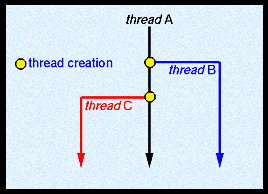- An operating system executes a variety of programs:
-Batch system – jobs
-Time-shared systems – user programs or tasks
- Textbook uses the terms job and process almost interchangeably
- Process – a program in execution; process execution must progress in sequential fashion
- A process includes:
-program counter
-stack
-data section
a.) Process State - As a process executes, it changes state: new: The process is being created
new: The process is being created
running: Instructions are being executed waiting:
The process is waiting for some event to occur
- ready: The process is waiting to be assigned to a processor
- terminated: The process has finished execution
b.) Process Control Block - a process in an operating system is represented by a data structure known as a process control block (PCB) or process descriptor. The PCB contains important information about the specific process including:
- The current state of the process i.e., whether it is ready, running, waiting, or whatever.
- Unique identification of the process in order to track "which is which" information.
- A pointer to parent process.
- Similarly, a pointer to child process (if it exists).
- The priority of process (a part of CPU scheduling information).
- Pointers to locate memory of processes.
- A register save area.
- The processor it is running on.
 The PCB is a certain store that allows the operating systems to locate key information about a process. Thus, the PCB is the data structure that defines a process to the operating systems. During a context switch, the running process is stopped and another process is given a chance to run. The kernel must stop the execution of the running process, copy out the values in hardware registers to its PCB, and update the hardware registers with the values from the PCB of the new process. Since the PCB contains the critical information for the process, it must be kept in an area of memory protected from normal user access. In some operating systems the PCB is placed in the beginning of the kernel stack of the process since that is a convenient protected location.
The PCB is a certain store that allows the operating systems to locate key information about a process. Thus, the PCB is the data structure that defines a process to the operating systems. During a context switch, the running process is stopped and another process is given a chance to run. The kernel must stop the execution of the running process, copy out the values in hardware registers to its PCB, and update the hardware registers with the values from the PCB of the new process. Since the PCB contains the critical information for the process, it must be kept in an area of memory protected from normal user access. In some operating systems the PCB is placed in the beginning of the kernel stack of the process since that is a convenient protected location.
c.) Threads - a thread is a single sequence stream within in a process. Because threads have some of the properties of processes, they are sometimes called lightweight processes. In a process, threads allow multiple executions of streams. In many respect, threads are popular way to improve application through parallelism. 
0 comments:
Post a Comment